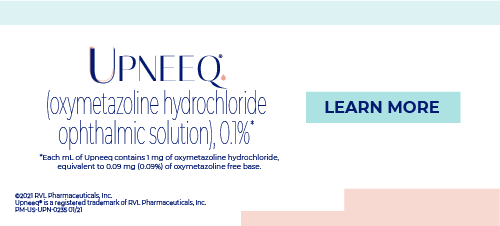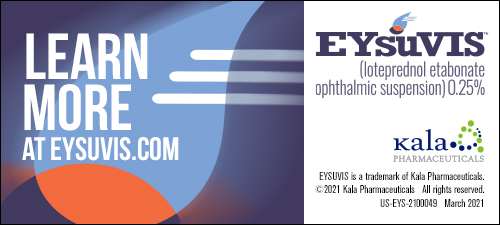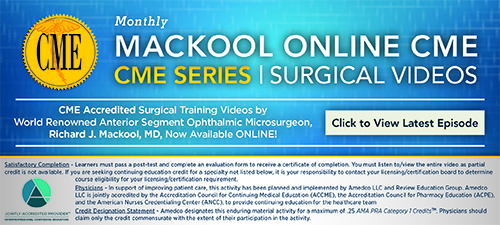| |
|
|
|
| Vol. 22, #12 • Monday, March 22, 2021 |
|
MARCH IS WORKPLACE EYE WELLNESS MONTH
|
|
| |
| |
|
10-2 vs. 24-2C Test Grids for Identifying Central VF Defects
Researchers compared the ability of 24-2C and 10-2 test grids in measuring visual field global indices, identifying central visual field defects and facilitating macular structure-function analysis with optical coherence tomography scans, for glaucoma suspects and glaucoma patients.
The prospective, cross-sectional study included one eye each from 131 glaucoma patients and 57 glaucoma suspects recruited from a referral-only, university-based glaucoma clinic.
Each subject underwent perimetric testing using 24-2C SITA-Faster and 10-2 SITA-Fast in random order, and Cirrus OCT macular imaging (ganglion cell analysis) for structure-function correlations.
Main outcome measures included: visual field global indices (mean deviation, pattern standard deviation, binarized “cluster” pass/fail and central mean sensitivity); number and proportion of visual field defects; and structure-function concordance with the Cirrus OCT deviation map following visual field location displacement for correspondence with underlying retinal ganglion cell position.
Here were some of the findings:
• Global indices (mean deviation, pattern standard deviation and central mean sensitivity) were similar between the 24-2C and 10-2 grids.
• The 10-2 detected more points of deficit compared to the 24-2C (p<0.0001 for all patients, p=0.006 for glaucoma patients). This was preserved when analyzing the proportion of defects in the central visual field for all patients (p=0.02) but wasn’t significantly different for glaucoma patients (p=0.051).
• The 10-2 identified more central “clusters” of 2+ contiguous points of deficit (p<0.0001).
• Structure-function comparisons performed at locations where visual field and OCT test locations were co-localized revealed greater concordance of structural and functional deficits using the 10-2 compared with the 24-2C (p<0.0001).
• The 10-2 took a median of 201 seconds, and the 24-2C a median of 154 seconds, corresponding to the different thresholding algorithms.
Researchers found that the 24-2C and 10-2 test grids returned similar global indices of visual field performance and proportionally similar amounts of central visual field loss. They added that the additional points in the 10-2 grid returned more “clusters” of defects and a greater rate of structure-function concordance compared with the 24-2C test grid. As such, they wrote, the 24-2C could identify the presence of a clustered central visual field defect using similar probability criteria, while the 10-2 might be more useful in characterizing the defect and predicting central visual function.
SOURCE: Phu J, Kalloniatis M. Comparison of 10-2 and 24-2C test grids for identifying central visual field defects in glaucoma and suspect patients. Ophthalmology 2021; Mar 12. [Epub ahead of print].
|
|
|
|
|
| |
Advertisement
|
|
|
|
| |
|
Response of Retinal NV to Aflibercept or PRP in PDR
Investigators wrote that eyes with proliferative diabetic retinopathy have a variable response to treatment with panretinal photocoagulation or anti-vascular endothelial growth factor agents. The location of neovascularization is associated with outcomes (e.g., patients with disc NV [NVD] have poorer visual prognosis than those with NV elsewhere [NVE]). Investigators researched the distribution of NV in patients with proliferative diabetic retinopathy and the topographical response of NV to treatment with aflibercept or PRP.
This post hoc analysis of the Phase IIb randomized, single-masked, multicenter noninferiority Clinical Efficacy and Mechanistic Evaluation of Aflibercept for Proliferative Diabetic Retinopathy (CLARITY) trial was conducted from November 1, 2019, to September 1, 2020, among 120 treatment-naive patients with proliferative diabetic retinopathy. The aim was to evaluate the topography of NVD and NVE in four quadrants of the retina on color fundus photography at baseline, and at 12 and 52 weeks after treatment.
In the CLARITY trial, patients were randomized to receive intravitreal aflibercept (2 mg/0.05 mL at baseline, four and eight weeks, and as needed from 12 weeks onward) or PRP (completed in initial fractionated sessions and then on an as-needed basis when reviewed every eight weeks).
The main outcomes were per-retinal quadrant frequencies of NV at baseline and frequencies of patterns of regression, recurrence and new occurrence at 12-week and 52-week unmasked follow-up.
The study included 120 treatment-naive patients (75 men; mean age, 54.8 ±14.6 years) with proliferative diabetic retinopathy. Here are some of the findings:
• At baseline:
o NVD with or without NVE was observed in 42 eyes (35 percent); and
o NVE-only was found in 78 eyes (65 percent); NVE had a predilection for the nasal quadrant (64 eyes [53.3 percent]).
• Rates of regression with treatment were higher among eyes with NVE (89 of 102 [87.3 percent]) vs. eyes with NVD (23 of 43 [53.5 percent]) by 52 weeks; NVD was more resistant to either treatment, with higher rates of persistence than NVE (20 of 39 [51.3 percent] vs. 29 of 100 [29 percent]).
• With NVE, the regression rate in the temporal quadrant was lowest (32 of 42 [76.2 percent]).
• Eyes treated with aflibercept showed higher rates of regression of NVE compared with those treated with PRP (50 of 52 [96.2 percent] vs. 39 of 50 [78 percent]; difference, 18.2 percent [CI, 5.5 to 30.8 percent]; p=0.01) but no difference was found for NVD (11 of 17 [64.7 percent] vs. 12 of 26 [46.2 percent]; difference, 18.6 percent [CI, -11.2 to 48.3 percent]; p=0.23).
This post hoc analysis found that disc neovascularization was less frequent although associated with more resistance to currently available treatments than neovascularization elsewhere. Investigators reported that aflibercept was superior to PRP for treating NVE, but neither treatment was particularly effective against NVD by 52 weeks. They suggested that future treatments would be needed to better target NVD, which has a poorer visual prognosis.
SOURCE: Halim S, Nugawela M, Chakravarthy U, et al. Topographical response of retinal neovascularization to aflibercept or panretinal photocoagulation in proliferative diabetic retinopathy: Post hoc analysis of the CLARITY Randomized Clinical Trial. JAMA Ophthalmol 2021; Mar 11. [Epub ahead of print].
|
|
|
|
|
|
|
| |
Advertisement
|
|
|
|
|
| |
|
Recovery of Contrast Sensitivity Post-DMEK
Scientists studied the change in contrast sensitivities in eyes with Fuchs’ endothelial dystrophy and bullous keratopathy after Descemet’s membrane endothelial keratoplasty.
In this prospective study, 50 pseudophakic eyes of 50 patients who received DMEK surgery at the Charité-Universitätsmedizin Berlin were included. Visual acuity; contrast sensitivity using OPTEC 6500 at spatial frequencies of 1.5, 3, 6, 12 and 18 cycles/degree in photopic and mesopic light with and without glare; central corneal thickness (CCT); and anterior and posterior corneal aberrations were measured preoperatively and at three and 12 months postoperatively.
Here were some of the findings:
• Best-corrected visual acuity (preoperative: 0.67 ±0.46 [a little better than 20/100]; after 12 months: 0.19 ±0.16 LogMAR [around 20/32]; p<0.001), and photopic and mesopic contrast sensitivities with and without glare improved significantly, while CCT decreased significantly (preoperative: 677 ±114 μm; after 12 months: 527 ±29 μm; p<0.001).
• Preoperative CCT correlated significantly with preoperative photopic contrast sensitivity (correlation coefficient, -0.462; p=0.002).
• Postoperative total anterior aberrations correlated with postoperative photopic contrast sensitivity (correlation coefficient, -0.361; p=0.006).
Scientists wrote that photopic and mesopic contrast sensitivities, especially with glare, were impaired in patients with Fuchs’ endothelial dystrophy and bullous keratopathy. They added that the extent of the corneal thickening seemed to mainly influence the contrast sensitivity preoperatively. Furthermore, scientists wrote, DMEK surgery improved the contrast sensitivity significantly, although higher postoperative anterior corneal aberrations limited postoperative contrast sensitivities.
SOURCE: Gundlach E, Pilger D, Brockmann T, et al. Recovery of contrast sensitivity after Descemet membrane endothelial keratoplasty. Cornea 2021; Feb 10. [Epub ahead of print].
|
|
|
|
|
| |
|
Ranibizumab and Aflibercept for Macular Edema in BRVO
Researchers compared the efficacy of ranibizumab (0.5 mg) and aflibercept (2 mg) in the treatment of cystoid macular edema due to branch retinal vein occlusion over 12 months. (Several of the authors are members of advisory boards for Novartis and Bayer, and some authors report receiving personal fees from Novartis, others from Bayer, outside the submitted work. One author received a research grant from Novartis.)
A multicenter, international, database observational study recruited 322 eyes initiating therapy in real-world practice over five years. The main outcome measure was mean change in EDTRS letter scores of visual acuity. Secondary outcomes included anatomic outcomes, percentage of eyes with VA >6/12 (70 letters), number of injections and visits, time to first inactivity, switching or non-completion.
Here were some of the findings:
• Generalized mixed effect models demonstrated that mean-adjusted, 12-month VA changes for ranibizumab and aflibercept were similar (CI, +10.8 [8.2 to 13.4] vs. +10.9 [8.3 to 13.5] letters, respectively; p=0.59).
• The mean adjusted change in central subfield thickness was greater for aflibercept than ranibizumab (-170 [CI, -153 to -187] µm vs. -147 (CI, -130 to -164) µm, respectively; p=0.001).
• The overall median (Q1, Q3) of 7 (4, 8) injections and 9 (7, 11) visits was similar between treatment groups.
• First grading of inactivity occurred sooner with aflibercept (p=0.01).
• Switching was more common from ranibizumab (37 eyes, 23 percent) than from aflibercept (17 eyes, 11 percent; p=0.002).
Researchers wrote that visual outcomes at 12 months in this assessment of ranibizumab and aflibercept for BRVO in real-world practice were generally good and similar for the two drugs.
SOURCE: Hunt AR, Nguyen V, Creuzot-Garcher CP, et al. Twelve-month outcomes of ranibizumab versus aflibercept for macular oedema in branch retinal vein occlusion: Data from the FRB! registry. Br J Ophthalmol 2021; Mar 12. [Epub ahead of print.]
|
|
|
|
|
|
|
|
|
Industry News
Blue Cross Blue Shield Updates Eylea Policy On AAO Urging
Blue Cross Blue Shield updated its policy on Eylea treatment to allow for continued coverage of patients who have lost three lines of vision on an eye chart. The American Academy of Ophthalmology had urged the insurer to reconsider its Eylea policy and requested a meeting to discuss the dangers of the policy and its impact on patient care. The insurer recently met with Academy leaders and explained that the policy was updated and that it would be notifying local plans.
New Data from Xipere Program
Clearside Biomedical says that new data published in the British Journal of Ophthalmology related to the clinical development program of its treatment Xipere, an investigational therapy with a proposed indication of macular edema associated with non-infectious uveitis, reveal “positive findings for development.”
• Data from AZALEA, an open-label safety trial found suprachoroidal triamcinolone acetonide injectable suspension injections in patients with non-infectious uveitis with or without macular edema, showed no new safety problems over 24 weeks. Read more.
• Data published from the Phase III PEACHTREE trial and MAGNOLIA extension study found that, over the course of 48 weeks, the median time to rescue therapy for patients with ME due to NIU treated with suprachoroidal CLS-TA was 257 days vs. 55.5 days for the sham control group. Read more.
• Additionally, half of the patients treated with CLS-TA who participated in the MAGNOLIA study didn’t require rescue therapy for up to nine months after the second treatment.
Opthea Treats First Patient in Phase III Trials of OPT-302 in Wet AMD
Opthea announced the first patient was treated in the Phase III clinical program of the company’s VEGF-C/D ‘trap’ inhibitor, OPT-302, in participants with treatment-naïve wet age-related macular degeneration.
Read more.
Foundation Aims to Improve Global Eye Care Through Education
The newly incorporated Ophthalmology Foundation, a “nonprofit organization that supports ophthalmic education to preserve and restore vision for people of all nations,” is laying the groundwork to improve global eye care and ophthalmic practice, particularly in low-resource and underserved countries. Led by a global board of ophthalmologists, ophthalmology professors and industry leaders, the foundation’s mission is to create opportunities for ophthalmic education around the world. Learn more.
| |
Complimentary CME Education Videos
|
|
|
|
J&J Vision Introduces Acuvue Oasys Multifocal and Expands Oasys Portfolio for Presbyopia Patients
Johnson & Johnson Vision introduced a new option for patients with presbyopia: Acuvue Oasys Multifocal Contact Lenses With Pupil Optimized Design. The new lens, available in the United States and Canada, builds on the Oasys 2-Week platform. According to the company, it includes pupil-optimized design technology used in the 1-Day Acuvue Moist Multifocal, to produce “sharp, reliable vision at all distances, enabling patients with presbyopia to see distant, intermediate and near objects.” The lens is available in daily disposables and reusables. Read more.
Visus Announces FDA Acceptance of IND for Presbyopia-correcting Eye Drop
Visus Therapeutics announced the FDA accepted the company’s Investigational New Drug Application to proceed with the clinical development program for Brimochol, a proprietary combination of carbachol and brimonidine tartrate, designed to be a once-daily eye drop to correct for the loss of near vision associated with presbyopia. Under this IND, Visus will initiate its planned Phase II clinical trial in the United States. Read more.
|
|
|
|
|
|
| |
Review of Ophthalmology® Online is published by the Review Group, a Division of Jobson Medical Information LLC (JMI), 19 Campus Boulevard, Newtown Square, PA 19073.
To subscribe to other JMI newsletters or to manage your subscription, click here.
To change your email address, reply to this email. Write "change of address" in the subject line. Make sure to provide us with your old and new address.
To ensure delivery, please be sure to add reviewophth@jobsonmail.com to your address book or safe senders list.
Click here if you do not want to receive future emails from Review of Ophthalmology Online.
Advertising: For information on advertising in this e-mail newsletter or other creative advertising opportunities with Review of Ophthalmology, please contact sales managers Michael Hoster, Michele Barrett or Jonathan Dardine.
News: To submit news or contact the editor, send an e-mail, or FAX your news to 610.492.1049
|
|
|
|
|
|
|
|